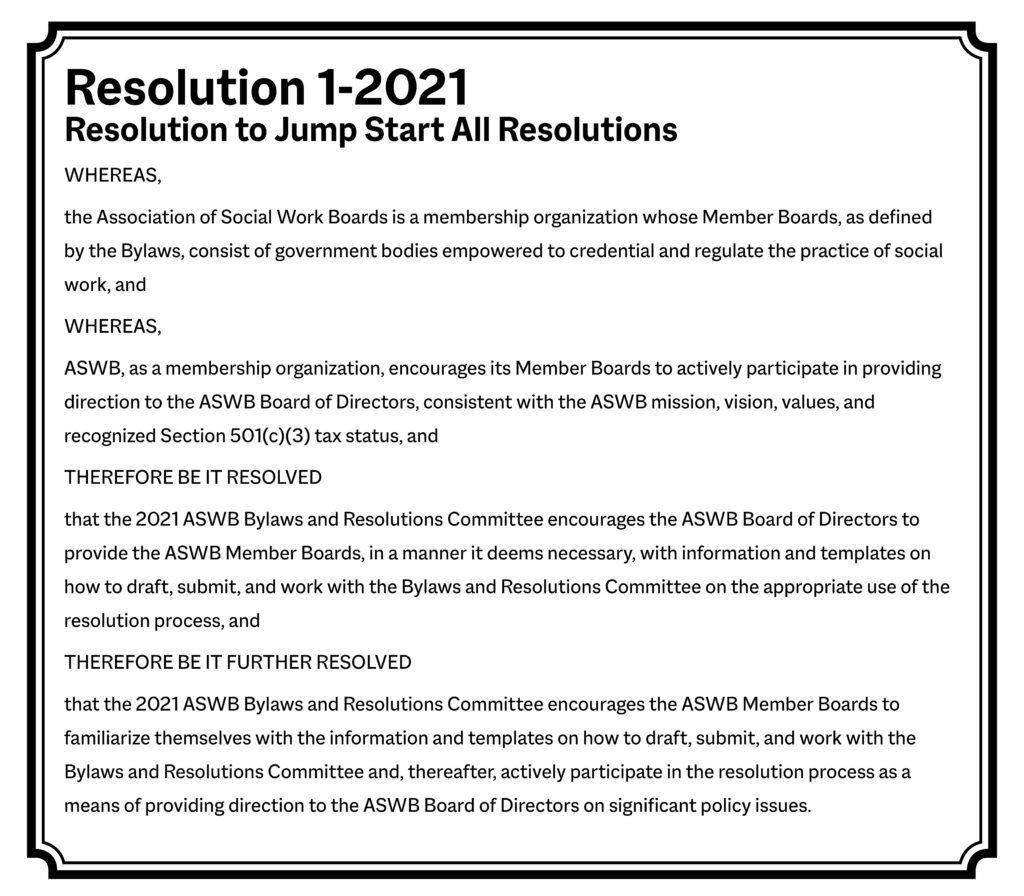Therefore, be it resolved

As emphasized at the 2021 ASWB Annual Meeting of the Delegate Assembly, resolutions provide an important opportunity for ASWB member boards to assist leadership of your organization in identifying and, where appropriate, implementing initiatives for the benefit of the association. The purpose of this month’s newsletter article is to address some of the fundamental aspects. With the notice inviting submission of resolutions coming in March, it is hoped that this information is timely and will benefit member boards.
Timeline
Resolutions are submitted well in advance of the annual meeting to allow the editing and final drafts of resolutions to follow a review process. According to ASWB Policy 4.2, resolutions shall be sponsored only by delegates, alternate delegates, the Board of Directors, or an ASWB committee. Proposed resolutions must be submitted not less than 120 days before the annual meeting. Policy 4.2(6) provides a mechanism for resolutions within the 120-day period related to matters of immediate concern.
Counsel's column
The Bylaws and Resolutions Committee may submit resolutions not less than 75 days before the annual meeting. The 120- and 75-day submission dates allow for the editing and discussion phase of the process to occur in a time frame that accommodates distribution of final resolutions to the membership before the annual meeting. Member board discussions prepare delegates for discussion and voting on the resolutions that come to the floor.
Process
The Bylaws Committee, with the assistance of staff and counsel, reviews submitted resolutions for consistency with the association’s mission and tax status and ensures that the resolution does not duplicate a previously adopted resolution. Discussions with the proposer of the resolution may be necessary to edit the language. The committee’s role is not to change the intent of the proposer. Ultimately, the proposer of the resolution has final determination as to the language.
Once resolutions are finalized, the committee will vote on and arrive at a “Do Pass,” “Do Not Pass,” or “No Recommendation” position. That position will be inserted into each resolution distributed to member boards.
At the annual meeting, the membership has an opportunity to discuss each final resolution before delegates vote to pass or not to pass. Rules of debate apply, and a simple majority is necessary to pass a resolution. No substantive amendments at the annual meeting are allowed, as such changes would alter the intent of the resolution and prevent member board discussions before a vote.
If a resolution fails to receive the majority vote, it does not pass, and the action item need not be addressed. If a resolution passes, it provides the Board of Directors with the expressed intent of the delegate body and the action item(s) will be undertaken by ASWB leadership and staff.
Structure
 Resolutions should have a series of WHEREAS clauses followed by THEREFORE BE IT RESOLVED clause(s). WHEREAS clauses contain facts and background that establish the importance of and need for the resolution to be addressed by ASWB. WHEREAS clauses should be factually accurate and avoid unsubstantiated data. The THEREFORE BE IT RESOLVED clauses are the requested action(s) the proposer wishes for ASWB to complete.
Resolutions should have a series of WHEREAS clauses followed by THEREFORE BE IT RESOLVED clause(s). WHEREAS clauses contain facts and background that establish the importance of and need for the resolution to be addressed by ASWB. WHEREAS clauses should be factually accurate and avoid unsubstantiated data. The THEREFORE BE IT RESOLVED clauses are the requested action(s) the proposer wishes for ASWB to complete.
The financial aspects of the subject matter of a resolution must be referenced. This sensitivity to the costs and staffing must be addressed, especially for significant undertakings. Resolutions that do not implicate financial obligations need not reference a financial impact assessment.
Purpose
The use of the resolution process provides ASWB member boards with an important avenue in providing guidance to elected leadership and staff. ASWB members have historically underutilized resolutions. It is hoped that the 2021 annual meeting session and this article will stimulate member board involvement in the resolution process.

